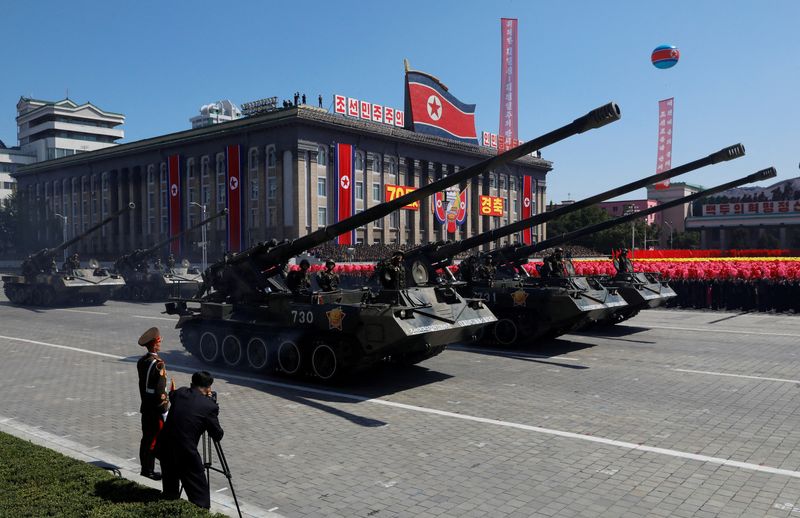Analysis-North Korean ammunition could offer Russian troops flawed but useful support
2023.09.12 01:05
3/3

© Reuters. FILE PHOTO: Self propelled artillery roll pass during a military parade marking the 70th anniversary of North Korea’s foundation in Pyongyang, North Korea, September 9, 2018. REUTERS/Danish Siddiqui/File Photo
2/3
By Josh Smith
SEOUL (Reuters) – If North Korea provides artillery rounds and other weapons to Russia for the war in Ukraine, it could help Kremlin forces stretch their dwindling stocks of ammunition but would unlikely to change the course of the conflict, military analysts say.
North Korean leader Kim Jong Un arrived in Russia on Tuesday for meetings with President Vladimir Putin, where U.S. officials say they expect both sides to pursue an arms deal.
North Korea is believed to have a large stockpile of artillery shells and rockets that would be compatible with Soviet-era weapons, as well as a history of producing such ammunition.
The size of these stores and its degradation over time is less clear, as is the scale of ongoing production, but these stockpiles could help replenish those severely depleted in Ukraine, said Joseph Dempsey, a defence researcher at the International Institute for Strategic Studies.
“While access to such stocks may prolong the conflict, it is unlikely going to change the outcome,” he added.
Both Ukraine and Russia have expended massive numbers of shells, and have looked to allies and partners around the world to refill their ammunition stockpiles.
Russia fired 10-11 million rounds last year in Ukraine, a Western official estimated on Friday.
Among the ammunition that the U.S. has provided Ukraine are shells with advanced capabilities, such as the Excalibur, which uses GPS guidance and steering fins to hit targets as small as 3 metres (10 feet) from up to 40km (25 miles) away.
North Korea’s offering is likely to be less high-tech but accessing those stocks would likely significantly increase Russia’s capabilities in the short term, while North Korean production lines would help in the longer term, said Siemon Wezeman, of the Stockholm International Peace Research Institute.
“Almost none of the ammunition is in any way ‘advanced’ – it would feed the traditional Russian barrage type use of artillery but not provide Russia with any precision ammunition,” he said.
To have minimal stocks for all their artillery in 100mm-152mm calibre would mean North Korea would have at least millions of shells stockpiled, Wezeman said, and just to replenish any ammunition fired in exercises or demonstrations will need some serious production capacities.
The White House has said Russia wants to buy “literally millions” of artillery shells and rockets from North Korea.
QUANTITY OVER QUALITY
Massed artillery fire has played a key role since Russia’s invasion of Ukraine, which it calls a “special military operation. Some analysts call artillery the “king of battle” despite the focus on flashier, high-tech weapons.
“Used correctly, artillery can shatter the will and cohesion of the enemy, offering significant opportunity to seize both ground and the initiative,” Patrick Hinton, a British Army fellow at the Royal United Services Institute, said in a recent report.
However, it is more complicated than simply throwing shells at the enemy, and Russian artillery barrages have repeatedly failed to dislodge entrenched Ukrainians, he wrote.
Hinton told Reuters the question of quality in North Korean artillery shells could have an impact if flaws fall outside accepted tolerances.
“Poorly made ammunition will have inconsistent performance – behaviours in flight may be affected which will reduce accuracy; poor quality fuses may lead to premature function; shelf life may be reduced if the content is poorly made,” he said. “These all need to be made to a high specification otherwise they may not land where they are expected to which can have catastrophic consequences.”
The performance of North Korea’s artillery and crews has been suspect since the North Korean army fired around 170 shells at the South Korean island of Yeonpyeong in 2010, killing four people.
According to a report by the Washington-based 38 North project, more than half those rounds fell in the waters around the island, while about 20% of those that impacted the island failed to explode.
Such a high failure rate suggested some North Korea-manufactured artillery munitions suffered from either poor quality control during manufacture or poor storage conditions and standards, the report said.
With very large numbers of ammunition, the lack of precision and the occasional dud shells or rockets wouldn’t matter much to the Russians, Wezeman said.
“However, it would matter if Korean ammunition is of such poor quality that it is just unsafe to use for Russian soldiers – there have been indications that such quality issues play with Korean ammunition,” he added.








